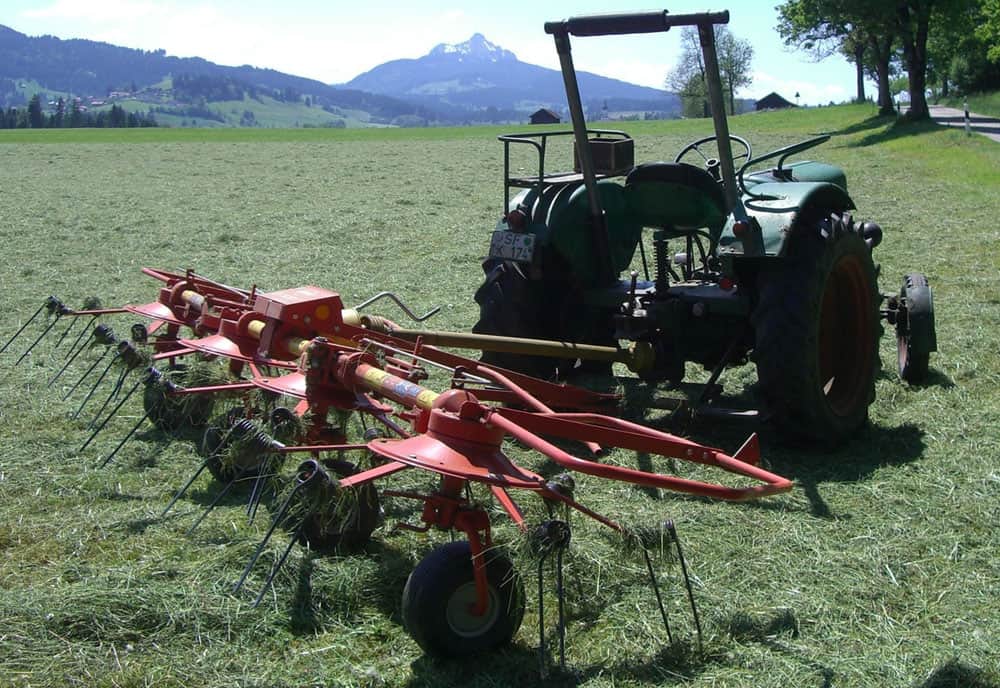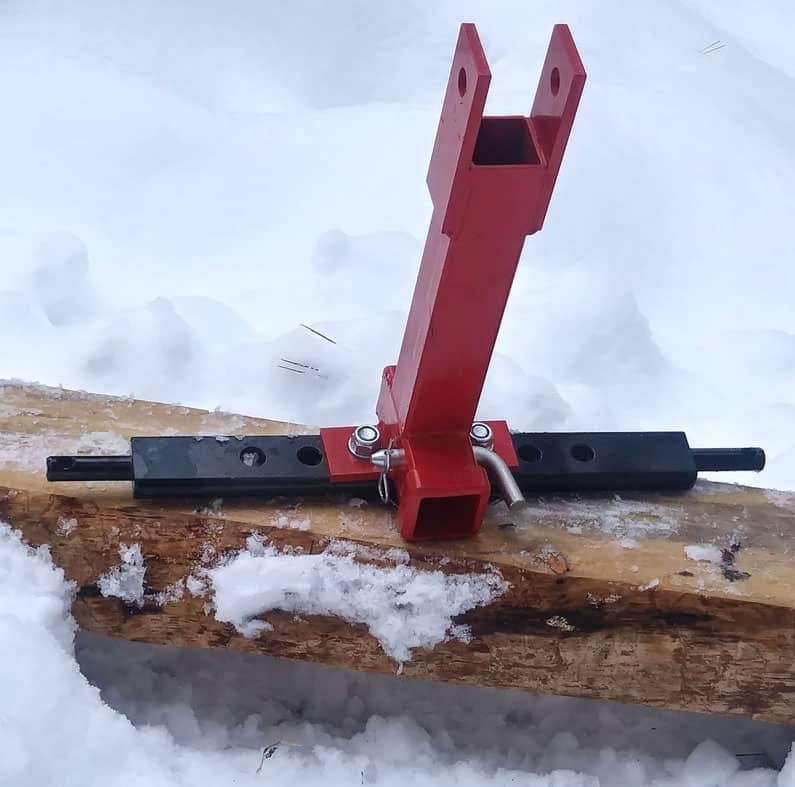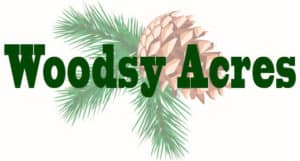
Once I was in the market for a compact tractor, I started looking into what types of implements were available. And, what might be needed to make my job of managing my property easier. Surprisingly there’s a lot that can be done with a tractor even if it’s something other than just farming. Below is a list of some of the useful implements that can be attached to a compact tractor for use on a small acreage, farm, or wooded property. Most implements utilize the tractors hydraulic system and its three-point hitch.
The Three-Point Hitch
You’ll hear the term 3 point hitch a lot in this article so before going too far let’s find out what is a 3 point hitch, where is it located, and what makes up a 3 point hitch?
It is a device on most tractors where implements are attached to using three connection points. The hitch typically located at the back end of a tractor. It resembles the letter A or a triangle due to the way the components get installed on the tractor.
The components to a 3 point hitch can consist of the following based on the size of the hitch and possibly the model of the tractor.
- The hydraulic system of the tractor that allows the lifting and lowering of attached implements.
- Lift arm
- Adjustable stabilizer arm
- Stabilizer bracket
- Lift arm leveling assembly
- Lynchpin
- Lower stay strap
- Drawbar
- Swinging drawbar
- Top Link
- Top Link pin
Hitches have various sizes based on the size of the tractor, and these hitch sizes are called categories. There are five categories, but most smaller compact tractor’s hitches will fall within category 0 and category 1. These two hitch categories cover tractors with engine sizes up to 45 hp.
Any pricing provided below are new prices and mostly for Cat 1 3-point hitches. For more significant hitches and tractors, these prices could increase. Also, these are only approximate price ranges and can change at any time. With some implements, there is a vast price range that has to do with the brand and features provided.
13 Implements In No Special Order
Front Loader: Based on everything I have read, the front loader is probably the most useful implement that can be attached to a compact tractor.
As stated in its name, the bucket is attached to the front end of the tractor. Then through the use of individual hoses and actuators, it is connected to the hydraulic system. Once joined, the loader can lift, lower, load, and dump materials into the front loader bucket.
Some buckets are set up with a quick load and release system. This system allows quick removal of the bucket in case there’s another implement needing attached such as a grappler or snowblower.
There are other attachments that you can add to the bucket such as debris forks, and independent forks. These can turn your tractor into a forklift for lifting and moving pallets. Or, in my case a way to lift logs and load them onto my portable sawmill.
Pricing: It is best to buy your new or used tractor with a loader already installed. Otherwise, the price of the loader and installation can cost several thousand dollars.
Brush Cutter – Purchased separately: Also known as a rotary mower, brush mower, and brush hog which is a lot like a grass mower only capable of mowing thicker stock woodsy plants approximately as thick as two inches. This implement also attaches to the tractor PTO which is what gives the rotary blades their ability to spin. (See below for more detail about a tractors PTO) With the implement attached to the PTO engaged, the blades spin and in turn cut (mows) down grass and brush.
Price Range: $850 – $3,900
Finish Mower: Like the brush cutter this implement is a rotary type mower with blades like a lawnmower under it. The finish mower design allows you to lower down far enough to be able to trim grass short and evenly. This tractor implement also utilizes the tractor PTO for its power. Cutting heights for finish mowers can have a range between .75 and 5.5 inches with various cutting widths up to 70 inches.
Price Range: $950 – $3,200
Rototiller: A rototiller or cultivator, uses curved tines mounted on a rotating shaft connected to your tractor’s PTO. When the PTO is engaged the tines dig and churn the soil int fine, and clod-free seedbed. Control the depth of the tiller by adjusting the skid shoe. The primary use for this implement is for gardening.
Price Range: $600 – $2,000+
Grading Blade: Ideal for reworking driveways, snow removal, cutting drains, and smaller areas for leveling. Great for scraping a small amount of material with each pass. The grader blade makes the perfect general purpose implement.
Price Range: $300 – over $1,500
Box Scraper: Primarily used for smoothing and contouring land along with moving dirt. Many box scrapers have adjustable shanks that dig into the soil to aid in gathering and moving dirt. There are two blades on the back of the box, one for pulling and the other for pushing when backing up the tractor. This implement is excellent for creating a new road or trail through your property. I use mine to maintain the existing roads as well as to start building a new road along with a few ATV trails throughout my acreage.
Price Range: $400 – $1,200
Boom Pole: A boom pole can be handy for tractors that don’t have a front loader attached, not to mention a lot less expensive too. Use the boom pole in combination with a strap or chain to lift heavy items for moving from one spot to another. It’s an excellent tool for skidding logs if you’re cutting trees or lift equipment to inspect, transfer or perform work.
Price Range: $115 – $400
Drawbar: Just about all compact tractors come with a drawbar located below the PTO box and is typically adjustable. Sometimes though you may need to haul or pull something that doesn’t have a long enough neck. Not allowing for a very sharp turning radius, makes hitching up difficult, or there’s a need to drag something using the 3-point hydraulic system. That’s when a 3-point sidebar can come in handy. The drawbar is the same device found on even the earliest tractors where a ball was used instead of a 3-point hitch to pull old farm implements.
From what I’ve found, there are a couple of different drawbars available for use on a tractors hitching system. Each of the two drawbars is designed to house a ball for hauling or a larger clevis for lifting something like a log, timber, or possibly a massive piece of steel.
One drawbar is a single bar that attaches to the stabilizer arms of the tractor that connect to the hydraulic system allowing it to raise up and down. This particular sidebar has multiple holes for various ball configurations. The disadvantage of this style of the drawbar is that the bar can rotate.
The second option keeps the sidebar stable because it is connected and stabilized using the 3 point hitch top link. There are also styles of this type that sport a 2″ receiver.
The balls for these drawbars and receivers are typically not included and sold separately.
3 point drawbar Price Range: $50 – $120
2 point drawbar Price Range: $20 – 50

Posthole Digger: An auger-type tool that is used to dig clean narrow holes for fence posts. It uses the PTO of your tractor to make digging easier and quicker. Depending on the size of a root, the auger post hole digger can often time cut through it. Certain types of roots, larger roots, and rocks can cause the auger to bind up and stop digging.
A best practice that I noted is to be patient and slowly drill down six to eight inches at a time and then lift the auger out of the ground to clear the dirt-filled flutes.
Price Range: $450 – $3,500
Landscape Rake: Which is unlike a typical type of yard rake. The landscape rake has tines designed for digging about two inches into the soil that aids in pulling out roots and rocks. Of course, the rake can also gather up loose debris, limbs, but not loose dirt, making it easier to move from one point to another.
Price Range: $350 – $1,200
If you want to get into really heavy-duty rakes with their hydraulic system you can spend upwards of $2,700.
Pine Straw Rake: If your property is made up of evergreen trees with long pine needles, an implement such as a pine straw rake could come in handy. The tines on this rake are shaped with a coil on them to give them more flexibility and are much smaller than the tines on a landscape rake.
Price Range: $185 – $560
Snow Blower: In a very snowy region, this can be a blessing of an implement. From what I learned, there are at least two types of blowers for your tractor.
The 3 point hitch blower that attaches to the back of the tractor to utilize the up and down lift of the hydraulic system and tractor’s PTO.
There is also a blower that is for the front which takes the place of the front bucket. This option helps by having the ability to lift, adjust, and tilt the blower in any of the positions you can with a bucket.
Price Range: $1,500 to over $8,900
Backhoe: Depending on the size of your tractor, this may or may not be a viable option. The smaller the tractor you have, the smaller the backhoe will be.
Pricing: Upwards and over $7,000
Miscellaneous Tractor Implements
Potential Implements for Small Farms – For small farm and homesteading use, there might be a need for a harrow disc, plow, seed planter, and spreader.
Stationary Implements – A couple of other implements, for your tractor, that can be attached but are more stationary type implements are a wood splitter and a wood chipper.
